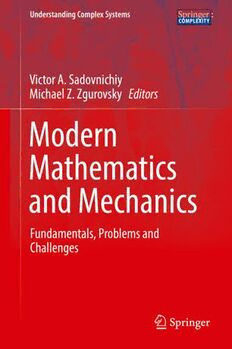Table Of ContentUnderstanding Complex Systems
Victor A. Sadovnichiy
Michael Z. Zgurovsky Editors
Modern
Mathematics
and Mechanics
Fundamentals, Problems and
Challenges
Springer Complexity
Springer Complexity is an interdisciplinary program publishing the best research and
academic-level teaching on both fundamental and applied aspects of complex systems—
cutting across all traditional disciplines of the natural and life sciences, engineering,
economics,medicine,neuroscience,socialandcomputerscience.
Complex Systems are systems that comprise many interacting parts with the ability to
generate anew qualityof macroscopic collectivebehavior themanifestations of whichare
the spontaneous formation of distinctive temporal, spatial or functional structures. Models
of such systems can be successfully mapped onto quite diverse “real-life” situations like
theclimate,thecoherentemissionoflightfromlasers,chemicalreaction-diffusionsystems,
biologicalcellularnetworks, thedynamicsofstockmarketsandoftheinternet,earthquake
statistics and prediction, freeway traffic, the human brain, or the formation of opinions in
socialsystems,tonamejustsomeofthepopularapplications.
Although their scope and methodologies overlap somewhat, one can distinguish the
following main concepts and tools: self-organization, nonlinear dynamics, synergetics,
turbulence,dynamicalsystems,catastrophes,instabilities,stochasticprocesses,chaos,graphs
and networks, cellular automata, adaptive systems, genetic algorithms and computational
intelligence.
ThethreemajorbookpublicationplatformsoftheSpringerComplexityprogramarethe
monograph series“Understanding ComplexSystems”focusing on thevariousapplications
of complexity, the “Springer Series in Synergetics”, which is devoted to the quantitative
theoreticalandmethodological foundations,andthe“SpringerBriefsinComplexity”which
are concise and topical working reports, case-studies, surveys, essays and lecture notes of
relevance to the field. In addition to the books in these two core series, the program also
incorporatesindividualtitlesrangingfromtextbookstomajorreferenceworks.
EditorialandProgrammeAdvisoryBoard
HenryAbarbanel,InstituteforNonlinearScience,UniversityofCalifornia,SanDiego,USA
DanBraha,NewEnglandComplexSystemsInstituteandUniversityofMassachusettsDartmouth,USA
Péter Érdi, Center for Complex Systems Studies, Kalamazoo College, USA and Hungarian Academy
ofSciences,Budapest,Hungary
KarlFriston,InstituteofCognitiveNeuroscience,UniversityCollegeLondon,London,UK
HermannHaken,CenterofSynergetics,UniversityofStuttgart,Stuttgart,Germany
ViktorJirsa,CentreNationaldelaRechercheScientifique(CNRS),UniversitédelaMéditerranée,Marseille,
France
JanuszKacprzyk,SystemResearch,PolishAcademyofSciences,Warsaw,Poland
KunihikoKaneko,ResearchCenterforComplexSystemsBiology,TheUniversityofTokyo,Tokyo,Japan
ScottKelso,CenterforComplexSystemsandBrainSciences,FloridaAtlanticUniversity,BocaRaton,USA
Markus Kirkilionis, Mathematics Institute and Centre for Complex Systems, University of Warwick,
Coventry,UK
JürgenKurths,NonlinearDynamicsGroup,UniversityofPotsdam,Potsdam,Germany
RonaldoMenezes,FloridaInstituteofTechnology,ComputerScienceDepartment,150W.UniversityBlvd,
Melbourne,FL32901,USA
AndrzejNowak,DepartmentofPsychology,WarsawUniversity,Poland
HassanQudrat-Ullah,SchoolofAdministrativeStudies,YorkUniversity,Toronto,ON,Canada
LindaReichl,CenterforComplexQuantumSystems,UniversityofTexas,Austin,USA
PeterSchuster,TheoreticalChemistryandStructuralBiology,UniversityofVienna,Vienna,Austria
FrankSchweitzer,SystemDesign,ETHZurich,Zurich,Switzerland
DidierSornette,EntrepreneurialRisk,ETHZurich,Zurich,Switzerland
StefanThurner,SectionforScienceofComplexSystems,MedicalUniversityofVienna,Vienna,Austria
Understanding Complex Systems
FoundingEditor:S.Kelso
Future scientific and technological developments in many fields will necessarily
dependuponcomingtogripswithcomplexsystems.Suchsystemsarecomplexin
boththeircomposition–typicallymanydifferentkindsofcomponentsinteracting
simultaneouslyandnonlinearlywitheachotherandtheirenvironmentsonmultiple
levels–andintherichdiversityofbehaviorofwhichtheyarecapable.
TheSpringerSeriesinUnderstandingComplexSystemsseries(UCS)promotes
new strategies and paradigms for understanding and realizing applications of
complex systems research in a wide variety of fields and endeavors. UCS is
explicitlytransdisciplinary.Ithasthreemaingoals:First,toelaboratetheconcepts,
methodsandtoolsofcomplexsystemsatalllevelsofdescriptionandinallscientific
fields,especiallynewlyemergingareaswithinthelife,social,behavioral,economic,
neuro-andcognitivesciences(andderivativesthereof);second,toencouragenovel
applicationsoftheseideasinvariousfieldsofengineeringandcomputationsuchas
robotics,nano-technologyandinformatics;third,toprovidea singleforumwithin
whichcommonalitiesanddifferencesintheworkingsofcomplexsystemsmaybe
discerned,henceleadingtodeeperinsightandunderstanding.
UCS will publish monographs, lecture notes and selected edited contributions
aimedatcommunicatingnewfindingstoalargemultidisciplinaryaudience.
Moreinformationaboutthisseriesathttp://www.springer.com/series/5394
Victor A. Sadovnichiy (cid:129) Michael Z. Zgurovsky
Editors
Modern Mathematics and
Mechanics
Fundamentals, Problems and Challenges
123
Editors
VictorA.Sadovnichiy MichaelZ.Zgurovsky
LomonosovMoscowStateUniversity NationalTechnicalUniversityofUkraine
Moscow,Russia “IgorSikorskyKyivPolytechnicInstitute”
Kyiv,Ukraine
ISSN1860-0832 ISSN1860-0840 (electronic)
UnderstandingComplexSystems
ISBN978-3-319-96754-7 ISBN978-3-319-96755-4 (eBook)
https://doi.org/10.1007/978-3-319-96755-4
LibraryofCongressControlNumber:2018958922
©SpringerInternationalPublishingAG,partofSpringerNature2019
Thisworkissubjecttocopyright.AllrightsarereservedbythePublisher,whetherthewholeorpartof
thematerialisconcerned,specificallytherightsoftranslation,reprinting,reuseofillustrations,recitation,
broadcasting,reproductiononmicrofilmsorinanyotherphysicalway,andtransmissionorinformation
storageandretrieval,electronicadaptation,computersoftware,orbysimilarordissimilarmethodology
nowknownorhereafterdeveloped.
Theuseofgeneraldescriptivenames,registerednames,trademarks,servicemarks,etc.inthispublication
doesnotimply,evenintheabsenceofaspecificstatement,thatsuchnamesareexemptfromtherelevant
protectivelawsandregulationsandthereforefreeforgeneraluse.
Thepublisher,theauthorsandtheeditorsaresafetoassumethattheadviceandinformationinthisbook
arebelievedtobetrueandaccurateatthedateofpublication.Neitherthepublishernortheauthorsor
theeditorsgiveawarranty,expressorimplied,withrespecttothematerialcontainedhereinorforany
errorsoromissionsthatmayhavebeenmade.Thepublisherremainsneutralwithregardtojurisdictional
claimsinpublishedmapsandinstitutionalaffiliations.
ThisSpringerimprintispublishedbytheregisteredcompanySpringerNatureSwitzerlandAG
Theregisteredcompanyaddressis:Gewerbestrasse11,6330Cham,Switzerland
Preface
The given collection of papers has been organized as a result of regular open
joint academic panels of research workers from the Faculty of Mechanics and
Mathematics of Lomonosov Moscow State University and Institute for Applied
Systems Analysis of the National TechnicalUniversity of Ukraine “IgorSikorsky
KyivPolytechnicInstitute.”Thisvolumeisdevotedtothefundamentalsofmodern
mathematics and mechanics. It attracted attention of researchers from leading
scientific schools of Brazil, France, Germany, Poland, Russian Federation, Spain,
Mexico,Ukraine,theUSA,andothercountries.
Modern technological applications require development and synthesis of fun-
damental and applied scientific areas, with a view to reducing the gap that
may still exist between theoretical basis used for solving complicated technical
problems and implementation of obtained innovations. To solve these problems,
mathematicians,mechanics,andengineersfromwideresearchandscientificcenters
have been working together. Results of their joint efforts, including differential
geometry,dynamicsofdifferentialanddifferenceequationsandapplications,solid
mechanics,andmodernmethodsofoptimizationandcontrol,arepartiallypresented
here. In fact, serial publication of such collected papers to similar seminars is
planned.
Thisisthesequelofearliervolumes:
(cid:129) Zgurovsky, Michael Z.; Sadovnichiy, Victor A. (Eds.) Continuous and Dis-
tributed Systems: Theory and Applications Series: Solid Mechanics and Its
Applications,Vol.211,2014,XIX,333p.33illus.,14illus.incolor.
(cid:129) Victor A. Sadovnichiy and Michael Z. Zgurovsky (Eds.), Continuous and
Distributed Systems: Theory and Applications, Volume II, Studies in Systems,
DecisionandControl,Volume30,2015,Springer,Heidelbergxxiv+375pp
(cid:129) VictorA.SadovnichiyandMichaelZ.Zgurovsky(Eds.),AdvancesinDynamical
Systems and Control, Studies in Systems, Decision and Control, Volume 69,
2016,Springer,Heidelbergxxii+471pp
v
vi Preface
Inthisvolume,weareplanningtofocusonthefundamentalsofmodernmathemat-
icsandmechanics:
(1) We provide the solutions to modern fundamental problems including the
complexity of computing of critical points for set-valued mappings, the
behaviorofsolutions(stability,existence,andlong-timebehaviorofsolutions,
attractorsandrepellers,numericalapproximations,chaos,entropy,andmany
other features characterizing the dynamics of solutions) of ordinary differ-
ential equations, partial differential equations, and difference equations, the
developmentofabstracttheoryofglobalattractorsformulti-valuedimpulsive
dynamicalsystems,etc.;
(2) The abstract mathematicalapproaches,such as differentialgeometry,differ-
ential equations,anddifferenceequations,are appliedto the practicalappli-
cations in solid mechanics, hydro-, aerodynamics, optimization, decision-
making theory, and control theory. In particular, in mechanics: classes of
Hamiltonian systems can be studied in terms of Fomenko-Zieschanginvari-
ants; in solid mechanics: an algorithm for splitting an equilibrium displace-
ment equation system with bulk forces for a transversely isotropic linearly
elasticmediumthatleadstothreeuncoupledequationswithcertaincanonical
fourth-orderdifferentialoperatorsinthethreecomponentsofthedisplacement
vector is described; in hydrodynamics: a simplified model of the trapped
vortex is applied to determine the optimal parameters of the control device
and dynamical system analysis is used to explore the performance of this
controlstrategy; in aerodynamics:the effects of airfoil thickness and angle-
of-attackonnonlinearwakeandwingdynamiccharacteristicsareexamined;
inoptimization:anoptimalboundarycontrolproblemforthesystemofnon-
linearintegro-differentialevolutionequation(cp.Burgers-Sivanskyequation)
describing the behavior of the flame front interface under some physical
assumptions is solved; in control: the methods of automation of impulse
processes control in cognitive maps with multirate sampling of measured
verticescoordinatesaredeveloped.
(3) We hope that these compilations will be of interest to mathematicians and
engineersworkingattheinterfaceofthesefields.
The book is addressed to a wide circle of mathematical, mechanical, and
engineeringreaders.
Moscow,RussianFederation VictorA.Sadovnichiy
Kyiv,Ukraine MichaelZ.Zgurovsky
May2018
International Editorial Board of This
Volume
Editors-in-Chief
(cid:129) V.A.Sadovnichiy,LomonosovMoscowStateUniversity,RussianFederation
(cid:129) M.Z.Zgurovsky,NationalTechnicalUniversityofUkraine“IgorSikorskyKyiv
PolytechnicInstitute”,Ukraine
Associate Editors
(cid:129) V.N.Chubarikov,LomonosovMoscowStateUniversity,RussianFederation
(cid:129) D.V.Georgievskii,LomonosovMoscowStateUniversity,RussianFederation
(cid:129) O.V. Kapustyan, National Taras Shevchenko University of Kyiv and Institute
for Applied System Analysis, National Technical University of Ukraine “Igor
SikorskyKyivPolytechnicInstitute”,Ukraine
(cid:129) P.O. Kasyanov, Institute for Applied System Analysis, National Technical
UniversityofUkraine“IgorSikorskyKyivPolytechnicInstitute”andWorldData
CenterforGeoinformaticsandSustainableDevelopment,Ukraine
(cid:129) J.Valero,UniversidadMiguelHernandezdeElche,Spain
Editors
(cid:129) TomásCaraballo,UniversidaddeSevilla,Spain
(cid:129) N.M. Dobrovol’skii, Tula State Lev Tolstoy Pedagogical University, Russian
Federation
(cid:129) E.A.Feinberg,StateUniversityofNewYorkatStonyBrook,USA
(cid:129) D.Gao,VirginiaTech,USA
(cid:129) MaríaJoséGarrido-Atienza,UniversidaddeSevilla,Spain
vii
viii InternationalEditorialBoardofThisVolume
(cid:129) D.Korkin,UniversityofMissouri,Columbia,USA
(cid:129) PedroMarín-RubioUniversidaddeSevilla,Spain
(cid:129) FranciscoMorillasUniversidaddeValencia,Spain
Contents
PartI DifferentialGeometry
1 Convergence Almost Everywhere of Orthorecursive
ExpansionsinSystemsofTranslatesandDilates ....................... 3
Vladimir V. Galatenko, Taras P. Lukashenko,
andVictorA.Sadovnichiy
1.1 Introduction........................................................... 3
1.2 ExpansioninaSystemofFunctionswithDyadicSupports........ 5
1.3 ResultforSystemsofTranslatesandDilates ....................... 9
1.4 ConcludingRemarks................................................. 10
References.................................................................... 11
2 Three-Dimensional Manifolds of Constant Energy and
InvariantsofIntegrableHamiltonianSystems.......................... 13
AnatolyT.FomenkoandKirillI.Solodskih
2.1 IntegrableHamiltonianSystemswithTwoDegrees
ofFreedom............................................................ 13
2.1.1 HamiltonianVectorFields ................................. 13
2.1.2 LiouvilleEquivalenceofHamiltonianIntegrable
Systems ..................................................... 14
2.1.3 Fomenko-ZieschangInvariants ............................ 15
2.1.4 SimpleExamplesofMolecules............................ 19
2.2 HomotopyInvariantsofQ3.......................................... 20
2.2.1 FundamentalGroupπ (Q3) ............................... 20
1
2.2.2 HomologyGroupH (Q3,Z)............................... 23
1
2.3 Reidemeister-FranzTorsion ......................................... 25
2.3.1 TheTorsionofaSimpleMolecule......................... 25
2.3.2 Corollaries .................................................. 26
2.4 IntegrableGeodesicFlowsinaPotentialFieldontheTorus
ofRevolution......................................................... 27
2.4.1 Introduction................................................. 27
ix

